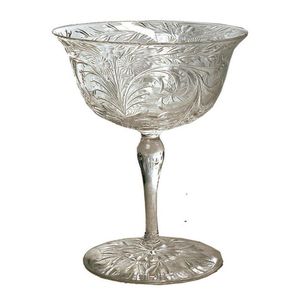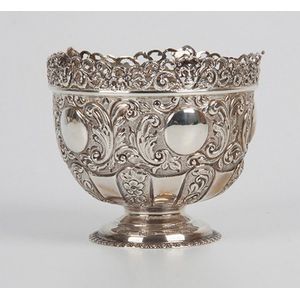Victorian Sterling Silver Floral Goblet with Inscription
You must be a subscriber, and be logged in to view price and dealer details.
Subscribe Now to view actual auction price for this item
When you subscribe, you have the option of setting the currency in which to display prices to $Au, $US, $NZ or Stg.
- Embossed / Repousse - Embossing, also known as repousse, is the technique of decorating metal with raised designs, by pressing or beating out the design from the reverse side of the object.It is the opposite of chasing, where the decoration is applied from the front. An embossed or repoussed object may have chasing applied to finish off the design.
- Engraving - The method of decorating or creating inscriptions on silver and other metal objects by marking the surface with a sharp instrument such as a diamond point or rotating cutting wheel.
- Sterling Silver - Sterling silver is a mixture of 92.5% pure silver and 7.5% of another metal, usually copper. Fine silver is 99.9% pure silver, and is relatively soft and the addition of the very small amount of copper gives the metal enough strength and hardness to be worked into jewellery, decorative and household objects.
- Angell Family of Silversmiths - There were a number of members of the Angell family who were silversmiths, commencing with Joseph Angell I (also expressed as Joseph Angell, Senior), and his brothers John Angell and Abraham Angell.
On the retirement of Joseph Angell I in 1948, from what had become the leading London silverware workshop, the business was taken over by his son, Joseph Angell II (also expressed as Joseph Angell, Junior), (1815 - 1891).
Joseph Angell II exhibited at the at the 1851 Great Exhibition, the 1853 New York Exhibition, and the 1862 International Exhibition winning medals at each event.
His career is marked by the rich silver items crafted and decorated with chiseling, reliefs and enamels, including trays, tea and coffee sets, jugs, centrepieces and vases
The Victoria and Albert Museum in London holds a number of silver objects by Jospeh Angell II. - Victorian Period - The Victorian period of furniture and decorative arts design covers the reign of Queen Victoria from 1837 to 1901. There was not one dominant style of furniture in the Victorian period. Designers used and modified many historical styles such as Gothic, Tudor, Elizabethan, English Rococo, Neoclassical and others, although use of some styles, such as English Rococo and Gothic tended to dominate the furniture manufacture of the period.
The Victorian period was preceded by the Regency and William IV periods, and followed by the Edwardian period, named for Edward VII (1841 ? 1910) who was King of the United Kingdom and the British Dominions and Emperor of India for the brief period from 1901 until his death in 1910.
This item has been included into following indexes:
Visually similar items

A set of ten Stevens and Williams champagne glasses, the bowls elaborately decorated with scrolling flowers and leaves.

A pair of silver cups, each embossed and chased with scrolls and with vacant cartouche

Victorian sterling silver footed Rosebowl with pierced floral, scroll and mask decorated gallery top, the body with embossed florals, scrolls and cartouche panels, London 1896, makers James Wakely & Frank Clarke Wheeler

George III sterling silver goblet, hallmarked London 1777 (marks rubbed), with later decoration, 16.1 cm high, 211 grams
